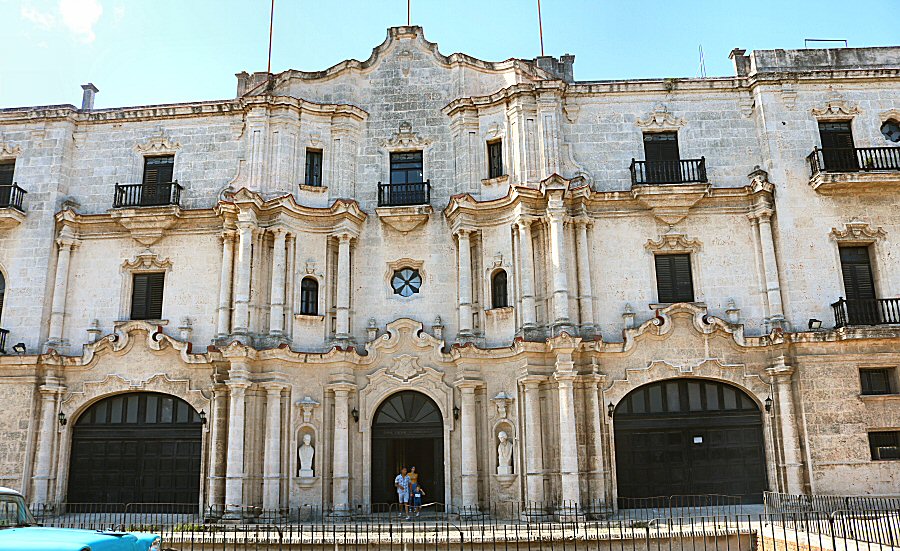

The
Seminary College of San Carlos is located on the San Ignacio
street #5, between the Empedrado and the Chacón streets, a few
meters from the Catedral de la Habana. The entrance of the
building is on the Cuba Tacón street.

The Seminary College of San Carlos
and San Ambrosio was one of the most important buildings of the colonial
period in Havana, not only due to its great architectural
value, but also it was a place, where many
prestigious
Cuban intellectuals received their formation. It was an
institution that once competed with the University of
Havana.
The Seminary College of San Ambrosio
is founded by the Bishop Diego Evelio de Compostela in a
house next to his house on the Compostela street in 1689. At
that time its name was Colegio de San Ambrosio.
Aurelius Ambrosius, better known as Ambrose,
was an Archbishop of Milan that became one of the most
influential ecclesiastical figures of the 4th century.
Twelve homeless boys were chosen to
prepare them for ordination to serve as clergy.
In the
18th century, when the Jesuits,
the largest missionary group in
Havana, obtained the necessary permission to build a new
church (current Cathedral of Havana), they started to
build also a new school on the plot where the prestigious College
of San José stood. The Jesuits were highly credited by their
discipline in following the precepts of the Catholic
religion, so that the children of the wealthy Creoles
residing in Havana, were receiving their education from the
Jesuits. The College of San José, in that the Jesuits held
office, was the preferred institution. The new school
building was completed just before the Jesuits were expelled
from Spain and the overseas territories in 1769.
Consequently, their property in Cuba was confiscated by the
colonial government. Thus, the Colegio de San Ambrosio
moved to the new building and it was
inaugurated under the name of Seminario de San Ambrosio in
1774. Seminary is a special school providing
education in theology, religious history, etc., primarily to
prepare students for the priesthood, ministry, or rabbinate.
In the time of the bishopric of Santiago José de Hechavarría
y Elguesúa (1725-1789)
some chairs like moral, philosophy and canons were added to
the school. In 1777, it was named Real y Conciliar Colegio
Seminario de San Carlos y San Ambrosio in honor of King
Carlos III, as the King of Spain equalized the seminary to
the Spanish seminaries and granted to the school the title
of Conciliar.
In the course of time,
the scularizetion of education in Cuba pushed the Seminario
San Carlos y San Ambroiso into the background. The Royal and
Pontifical University of San Gerónimo de La Habana (current
University of Havana) became the center of modern sciences,
whereas the seminary stayed exclusively as a religious
school.
In the time of the
Cardinal Manuel Arteaga Betancourt (1879-1963) the seminary
was named El Buen Pastor (The Good Shepherd) and it was
decided to move it to a new building. The seminary with its
new name Seminario Interdiocesano San Carlos y San Ambrosio
(San Carlos and San Ambrosio Interdiocesan Seminary) was
inaugurated in Guanabacao in 2010. At the door of the new
building, the first stone of the seminary is kept in a glass
urn; it was blessed by Pope John Paul II during his visit to
Cuba in 1998.
The original bulding on the Cuba
Tacón street was visited by Pope Francis during his visit to
Cuba in 2015. Currently it houses the Father Félix Varela
Cultural Center, a Catholic institution governed by the
Archidiocese of Havana.
Within their
activities, they offer conferences, literary, historical and
social panels, musical evenings and plastic arts
exhibitions.
The prominent figures of
the Cuban nation that passed through the classroom of the
seminary:
Carlos
Manuel de Céspedes
Félix
Varela and Morales
José
Agustín Caballero
José de
la Luz y Caballero
Tomás
Romay Chacón
Cirilo
Villaverde
Rafael
María de Mendive
José Antonio Saco